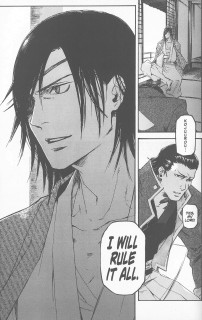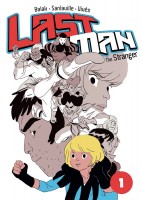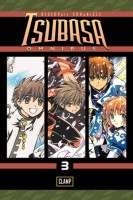My News and Reviews
Two more in-depth manga reviews were posted at Experiments in Manga last week, and once again they were both for manga. Though, unlike the week before which featured newer manga, last week’s reviews focused on a couple of older titles, one of which is actually out of print. That would be After School Nightmare, Volume 3 by Setona Mizushiro. This is the last volume in the series that I had previously read before embarking on my monthly horror manga review project, so I’m particularly curious to see where the manga goes from here. But, since next month’s horror manga review will be Mushishi, Volume 3, I’ll have to wait until June to find out. The other review posted last week was for Yak Haibara’s Sengoku Basara: Samurai Legends, Omnibus 1. Technically, it’s an adaptation of the Sengoku Basara 2 video game, but no familiarity with the games are needed and it stands alone as its own work. In addition to the incredibly over-the-top and badass characters and fight sequences, there’s actually some legitimate history mixed in as well. I find the series highly entertaining.
There wasn’t a lot in the way of manga news and announcements that I saw last week. (Granted, I was pretty busy paying attention to more pressing matters). If I missed something noteworthy, please do let me know! I would, however, like to mention Vertical’s ask.fm account, which continues provide a bit of fun in addition to excellent insight into the North American manga industry. I was particularly interested in the answer to a question about the impact of libraries on book sales since I happen to be a librarian. Also, Seven Seas has an ask.fm account, too, which I tend to forget about for some reason. Elsewhere online, Organization Anti-Social Geniuses has an interesting article about a used bookstore owner who nabbed more than 400 volumes of manga without even really knowing a thing about manga. Finally, two of Deb Aoki’s manga articles for Publishers Weekly were recently released from behind a paywall: Manga Publishing Update, Spring 2015 and Manga Publishers Try Games, Erotica to Grow Market.
Quick Takes
 Karneval, Omnibus 1 (equivalent to Volumes 1-2) by Touya Mikanagi. Gareki is a fairly successful thief, but when a burglary doesn’t exactly go according to plan, he becomes the accidental protector of a strange young man called Nai and the both of them suddenly find themselves drawing the attention of Circus, a powerful association charged with dealing with criminals and situations regular law enforcement can’t handle. When Karneval was licensed, a resounding cry went up from its fans. I can definitely understand the appeal of the series. It has action and adventure, some sweetness as well as darkness, heroes with tragic backstories, mysteries and secret (and not-so-secret) organizations, quirky and attractive characters and designs (mostly men, but a few women as well), and so on. But although I thoroughly enjoyed parts of the first omnibus of Karneval, it didn’t quite grab my attention as much as I was hoping, or expecting, it would. I think this may be because the worldbuilding doesn’t feel as cohesive as I would like it to be. Mikanagi is smashing together some interesting and engaging elements and ideas, but they’re not quite meshing yet. However, I suspect the connections will become clearer as the series progresses.
Karneval, Omnibus 1 (equivalent to Volumes 1-2) by Touya Mikanagi. Gareki is a fairly successful thief, but when a burglary doesn’t exactly go according to plan, he becomes the accidental protector of a strange young man called Nai and the both of them suddenly find themselves drawing the attention of Circus, a powerful association charged with dealing with criminals and situations regular law enforcement can’t handle. When Karneval was licensed, a resounding cry went up from its fans. I can definitely understand the appeal of the series. It has action and adventure, some sweetness as well as darkness, heroes with tragic backstories, mysteries and secret (and not-so-secret) organizations, quirky and attractive characters and designs (mostly men, but a few women as well), and so on. But although I thoroughly enjoyed parts of the first omnibus of Karneval, it didn’t quite grab my attention as much as I was hoping, or expecting, it would. I think this may be because the worldbuilding doesn’t feel as cohesive as I would like it to be. Mikanagi is smashing together some interesting and engaging elements and ideas, but they’re not quite meshing yet. However, I suspect the connections will become clearer as the series progresses.
 Manga Dogs, Volume 3 by Ema Toyama. The third volume of Manga Dogs is also its last. It’s an amusing gag manga, but I think three volumes is just about right for the series. If it was stretched out for too much longer, it would likely become tiresome. Manga Dogs requires a high-tolerance for shallow characters, foolish comedy, and general absurdity. Although there is something of an overarching storyline, Manga Dogs tends to be fairly episodic, relying on the jokes to carry the manga more so than the characters or plot. As for the plot, at this point in the series Tezuka’s manga Teach Me Buddha is unsurprisingly in danger of cancellation as is the school’s manga program. Tezuka and the three air-headed male students who have attached themselves to her must work together in order to stop that from happening. Anyone who has read the first two volumes of Manga Dogs probably already has a pretty good idea of how well that works. I find Manga Dogs to be funniest when the humor directly ties into the manga industry or the mangaka’s creative processes. Although it’s taken quite seriously by Tezuka and the others, I’d actually be interested in reading Teach Me Buddha as a parody of shoujo manga; it has the potential to be funnier than Manga Dogs manages to be.
Manga Dogs, Volume 3 by Ema Toyama. The third volume of Manga Dogs is also its last. It’s an amusing gag manga, but I think three volumes is just about right for the series. If it was stretched out for too much longer, it would likely become tiresome. Manga Dogs requires a high-tolerance for shallow characters, foolish comedy, and general absurdity. Although there is something of an overarching storyline, Manga Dogs tends to be fairly episodic, relying on the jokes to carry the manga more so than the characters or plot. As for the plot, at this point in the series Tezuka’s manga Teach Me Buddha is unsurprisingly in danger of cancellation as is the school’s manga program. Tezuka and the three air-headed male students who have attached themselves to her must work together in order to stop that from happening. Anyone who has read the first two volumes of Manga Dogs probably already has a pretty good idea of how well that works. I find Manga Dogs to be funniest when the humor directly ties into the manga industry or the mangaka’s creative processes. Although it’s taken quite seriously by Tezuka and the others, I’d actually be interested in reading Teach Me Buddha as a parody of shoujo manga; it has the potential to be funnier than Manga Dogs manages to be.
 Yamada-kun and the Seven Witches, Volume 1 by Miki Yoshikawa. I first learned about Yamada-kun and the Seven Witches when it was added to Crunchyroll Manga. I heard very good things about it at the time, and it sounded like something that I would enjoy, so I was very pleased when Kodansha Comics picked it up for print release. I’ll admit, I tend to enjoy body-swap manga, especially when there is some gender-swapping involved. (Which, now that I think about it, is probably more often the case than not.) Yamada-kun and the Seven Witches is one of the most entertaining examples of that particular subgenre that I’ve read recently. At this point, the series is definitely being played as a comedy. The trigger for the body-swapping is kissing, and there certainly is plenty of that in the first volume. Girls kissing guys. Guys kissing other guys. (Perhaps later on in the series, there will even be girls kissing other girls.) There are kisses for everyone! Not unexpectedly, there is also a bit of fanservice. However, for the most part it doesn’t tend to be overly sexualized and generally makes sense within context of the manga. Yoshikawa used to be an assistant to Fairy Tail‘s Hiro Mashima; some of that influence can easily be seen in the artwork of Yamada-kun and the Seven Witches.
Yamada-kun and the Seven Witches, Volume 1 by Miki Yoshikawa. I first learned about Yamada-kun and the Seven Witches when it was added to Crunchyroll Manga. I heard very good things about it at the time, and it sounded like something that I would enjoy, so I was very pleased when Kodansha Comics picked it up for print release. I’ll admit, I tend to enjoy body-swap manga, especially when there is some gender-swapping involved. (Which, now that I think about it, is probably more often the case than not.) Yamada-kun and the Seven Witches is one of the most entertaining examples of that particular subgenre that I’ve read recently. At this point, the series is definitely being played as a comedy. The trigger for the body-swapping is kissing, and there certainly is plenty of that in the first volume. Girls kissing guys. Guys kissing other guys. (Perhaps later on in the series, there will even be girls kissing other girls.) There are kisses for everyone! Not unexpectedly, there is also a bit of fanservice. However, for the most part it doesn’t tend to be overly sexualized and generally makes sense within context of the manga. Yoshikawa used to be an assistant to Fairy Tail‘s Hiro Mashima; some of that influence can easily be seen in the artwork of Yamada-kun and the Seven Witches.










